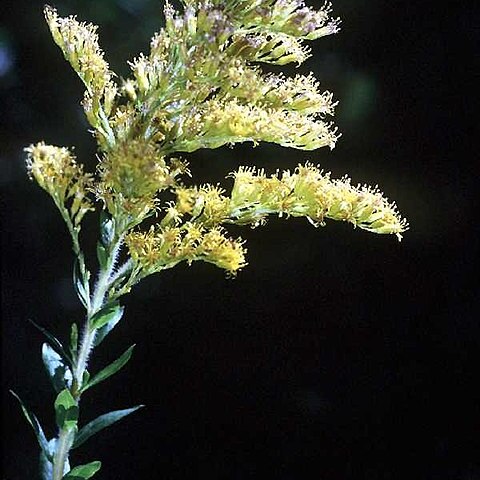Plants 50–150 cm; rhizomes creeping, elongated, sparsely scaly. Stems 1–20+, erect (stout), conspicuously spreading-hirsute, at least distally. Leaves: basal and proximal cauline usually withering by flowering except on new shoots, tapering to broadly winged petioles, blades oblanceolate, 30–50 × 8–15 mm, rapidly increasing in size distally, margins shallowly serrate, scabroso-strigose, faces often more densely hairy than distal; mid to distal cauline numerous, crowded, sessile, blades lanceolate-ovate to elliptic-oblong, larger ones 35–120 × 8–35 mm, much reduced distally, bases broad and ± clasping, margins obscurely serrulate or entire, faces usually moderately hirsuto-villous on midnerves, often less so abaxially, adaxial sparsely strigose or glabrous. Heads 35–500, in paniculiform arrays, usually dense, branches recurved-secund. Peduncles 2–8 mm, sparsely to moderately strigillose; bracteoles 1–3, linear to linear-lanceolate, tending to group proximal to involucres, sometimes grading into phyllaries. Involucres narrowly campanulate, 3.5–5.5 mm. Phyllaries in 4–5 series, unequal, glabrous; outer narrowly ovate-lanceolate, mid and inner linear-lance-olate. Ray florets (2–)4–10; laminae 1.2–2.5 × 0.2–0.5 mm. Disc florets (2–)4–7; corollas 4–5 mm, lobes 0.5–1 mm. Cypselae (narrowly obconic) 1.5–1.8 mm, sparsely strigillose, sometimes only apically; pappi 3–4 mm. 2n = 18.
More
Stems 7–15 dm from long creeping rhizomes, stout, conspicuously spreading-hirsute, at least above the middle; lvs chiefly cauline, numerous, crowded, strongly hirsute on the midrib beneath, and often less densely so across the surface, less hairy or more often glabrous above, sessile, broad-based and somewhat clasping, lance-ovate to elliptic-oblong, obscurely serrulate or subentire, the larger ones 3.5–12 × 1–3.5 cm; infl paniculiform, usually dense, with recurved-secund branches; invol glabrous, 3.5–5 mm, its bracts thin and slender; rays 7–12, small; disk fls 4–7; achenes short-hairy; 2n=18. Wet or dry places, often in pinelands; N.J. to Fla. and La., mainly on the coastal plain.
Mostly wetter sandy soils, seepage areas, boggy grounds, edges of marshes and thickets, open pine woodlands, roadside ditches from sea level to 100 metres.

